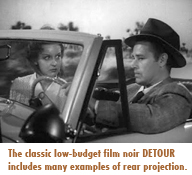 Longtime readers know we’re awfully fond of old movies, and we watch them in a very specific way: Yes, we appreciate good plotting, strong acting, interesting camera work, and sparkling dialogue, but when watching an old movie, we’re also focused on the small details that we suspect elude most viewers.
Longtime readers know we’re awfully fond of old movies, and we watch them in a very specific way: Yes, we appreciate good plotting, strong acting, interesting camera work, and sparkling dialogue, but when watching an old movie, we’re also focused on the small details that we suspect elude most viewers.
As vintage fashion buffs, we check out the ties the male characters are wearing and, if we get a glimpse of them, their socks. We note what style of hat they wear—how wide the brim is, how high the crown, the width of the ribbon.
We keep our eyes peeled for advertising posters and billboards to see if an interesting, previously unknown to us product is touted there. We listen carefully for forgotten usages in the dialogue.
In short, we try to glean everything about life as it was lived then that motion picture can teach us.
We even look out the rear and side windows when scenes are set in automobiles, and when two characters are conversing on a train, the chances are good we’ll sneak a peek out the window, to see what’s going on in the world passing by. The outside world in those scenes is represented by a process plate, a rear projection—the characters are almost never in a real automobile or railroad car—and periodically we come across some of that background footage. When we do, we like to share it with you.
The process footage seen below, shot from a train, dates from the 1930s and depicts a small town and its rural environs.
In our youth (and we’ll admit it, even today) we enjoyed watching the rows of a corn field open up to us. You know that phenomenon, yes? The way a field of solid green reveals its rows to you when you view it from a particular angle as you motor by?
If you’re not sure what we mean, no worries. Just watch this video; you’ll see, at the 2:30 mark, the effect we’re talking about on the far right side of the video window. We don’t have a term for this, but we’re open to suggestions. We think it deserves a name.
